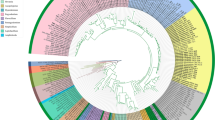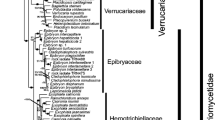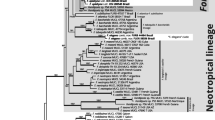Abstract
The genus Fusicladium s. lat. (incl. Pollaccia and Spilocaea) was phylogenetically analysed using ITS nrDNA sequences. Pollaccia and Spilocaea did not form monophyletic groups of their own, but were intermingled between Fusicladium species, together with which they formed a monophyletic clade. Thus, Pollaccia and Spilocaea should be included in a wider genus concept of Fusicladium, constituting a morphologically variable genus. Furthermore, all Venturia and Fusicladium isolates clustered together on the bases of available ITS data, providing support for the monophyly of the anamorphic genus Fusicladium and the teleomorphic genus Venturia. Within this clade several subclades can be recognized. All taxa on the host family Salicaceae were found in one subclade. Three other subclades comprised taxa on Rosaceae whereas taxa on other host families all clustered separately. Geographic specializations were not observed. Two examples of host switching could be demonstrated, but these were confined to instances involving host species belonging to the same family. Fusicladium convolvularum and F. effusum, two species with unknown teleomorphs, clustered within the Fusicladium/Venturia clade, supporting the correct placement of these taxa in Fusicladium. The placement of Pseudocladosporium hachijoense within the family Venturiaceae was also supported.
Similar content being viewed by others
References
Bhattacharya D, Friedl T, Damberger S (1996) Nuclear-encoded rDNA group I introns: Origin and phylogenetic relationships of insertion site lineages in the green algae. — Molecular Biology and Evolution 13: 978–989.
Braun U (1998) A monograph of Cercosporella, Ramularia and allied genera (phytopathogenic hyphomycetes). Vol. 2. pp. 493. IHW-Verlag, Eching.
Braun U, Crous PW, Dugan F, Groenewald JZ, Hoog GS de (2003) Phylogeny and taxonomy of Cladosporium-like hyphomycetes, including Davidiella gen. nov., the teleomorph of Cladosporium s.str. — Mycological Progress 2: 3–18.
Bridge PD, Roberts PJ, Spooner BM, Panchal G (2003) On the unreliability of published DNA sequences. — New Phytologist 160: 43–48.
Crous PW, Aptroot A, Kang JC, Braun U, Wingfield MJ (2000) The genus Mycosphaerella and its anamorphs. — Studies in Mycology 45: 107–121.
Crous PW, Braun U (2003) Mycosphaerella and its anamorphs: 1. Names published in Cercospora and Passalora. — CBS Biodiversity Series 1: 1–571.
Crous PW, Kang JC, Braun U (2001) A phylogenetic redefinition of anamorph genera in Mycosphaerella based on ITS rDNA sequences and morphology. — Mycologia 93: 1081–1101.
Ho MHM, Castañeda RF, Dugan FM, Jong SC (1999) Cladosporium and Cladophialophora in culture: descriptions and an expanded key. — Mycotaxon 72: 115–157.
Holst-Jensen A, Vrålstad T, Schumacher T (2004) On reliability. — New Phytologist 161: 11–13.
Huss VAR, Frank C, Hartmann EC, Hirmer M, Kloboucek A, Seidel BM, Wenzeler P, Kessler E (1999) Biochemical taxonomy and molecular phylogeny of the genus Chlorella sensu lato (Chlorophyta). — Journal of Phycology 35: 587–598.
Kasanen R, Hantula J, Kurkela T (2001) The occurrence of an undescribed species of Venturia in blighted shoots of Populus tremula. — Mycological Research 105: 338–343.
Partridge EC, Morgan-Jones G (2003) Notes on Hyphomycetes. XC. Fusicladosporium, a new genus for cladosporium-like anamorphs of Venturia. — Mycotaxon 85: 357–370.
Posada D, Crandall KA (1998) Modeltest: testing the model of DNA substitution. — Bioinformatics 14: 817–818.
Reynolds DR (1993) The fungal holomorph: an overview. In REYNOLDS DR, TAYLOR JW (eds) The Fungal Holomorph: mitotic, meiotic and pleomorphic speciation in fungal systematics, pp. 15–25. CAB International, Wallingford.
Schnabel G, Schnabel EL, Jones AL (1999) Characterization of ribosomal DNA from Venturia inaequalis and its phylogenetic relationship to rDNA from other tree-fruit Venturia species. — Phytopathology 89: 100–108.
Schubert K, Ritschel A, Braun U (2003) A monograph of Fusicladium s.lat. (Hyphomycetes). — Schlechtendalia 9: 1–132.
Swofford DL (2002) PAUP*. Phylogenetic analysis using Parsimony (*and other Methods). Version 4.0b10. Sunderland, Massachusetts: Sinauer Associates.
White TJ, Bruns T, Lee S, Taylor J (1990) Amplification and direct sequencing of fungal ribosomal RNA genes for phylogenetics. In Innes MA, Gelfand DH, Sninsky JJ, White TJ (eds) PCR Protocols: A guide to methods and applications, pp. 315–322. Academic Press, New York.
Author information
Authors and Affiliations
Corresponding author
Rights and permissions
About this article
Cite this article
Beck, A., Ritschel, A., Schubert, K. et al. Phylogenetic relationships of the anamorphic genus Fusicladium s. lat. as inferred by ITS nrDNA data. Mycol Progress 4, 111–116 (2005). https://doi.org/10.1007/s11557-006-0114-8
Accepted:
Issue Date:
DOI: https://doi.org/10.1007/s11557-006-0114-8




